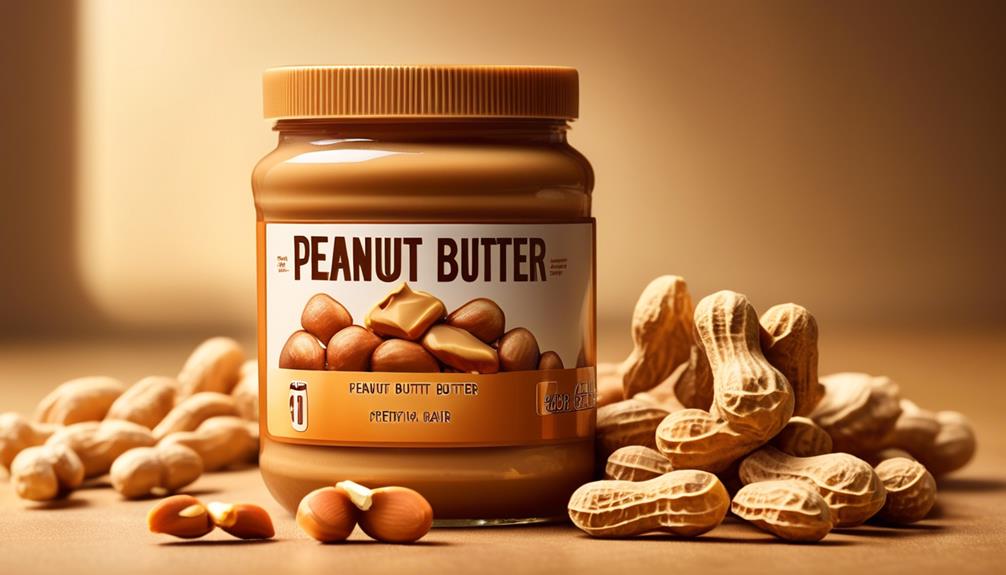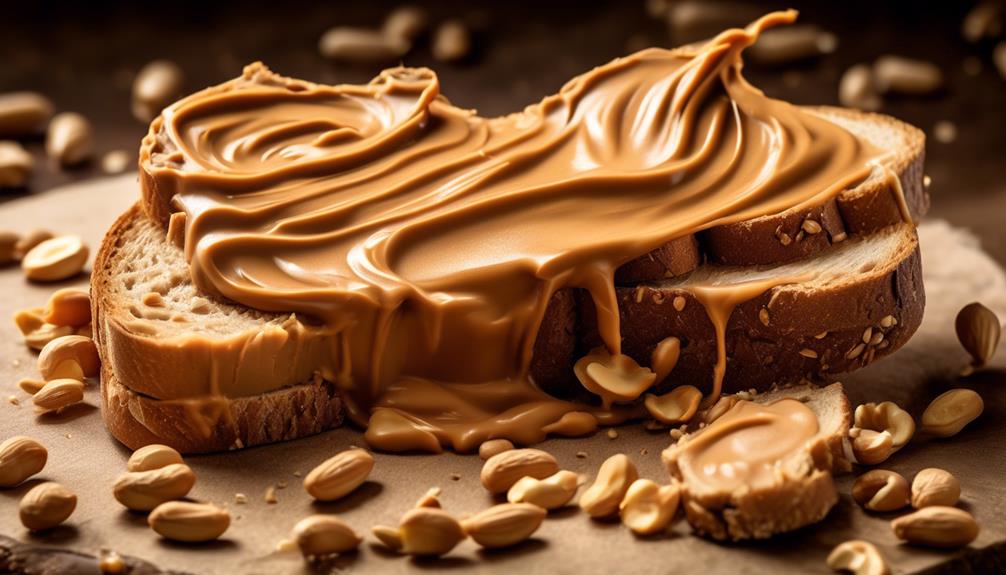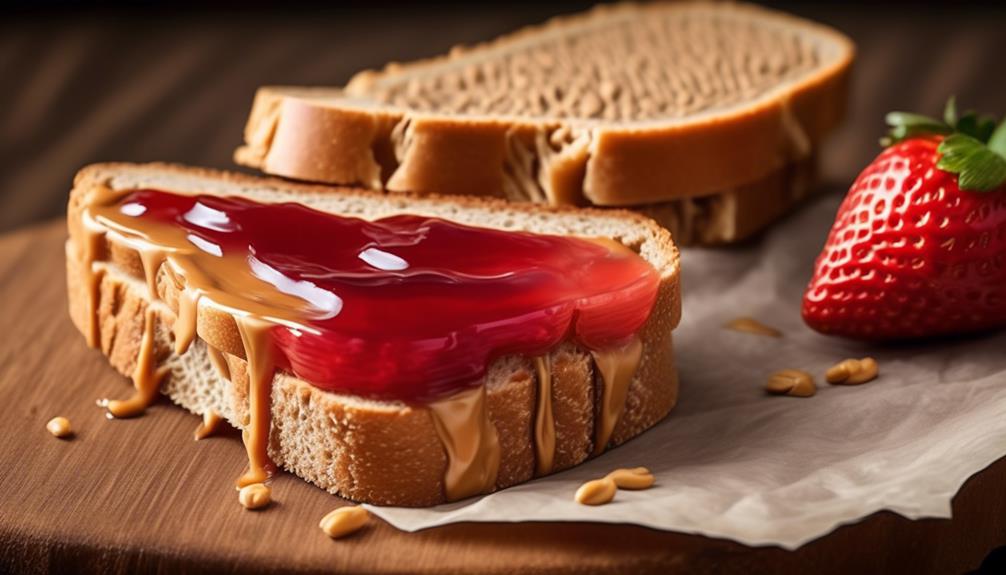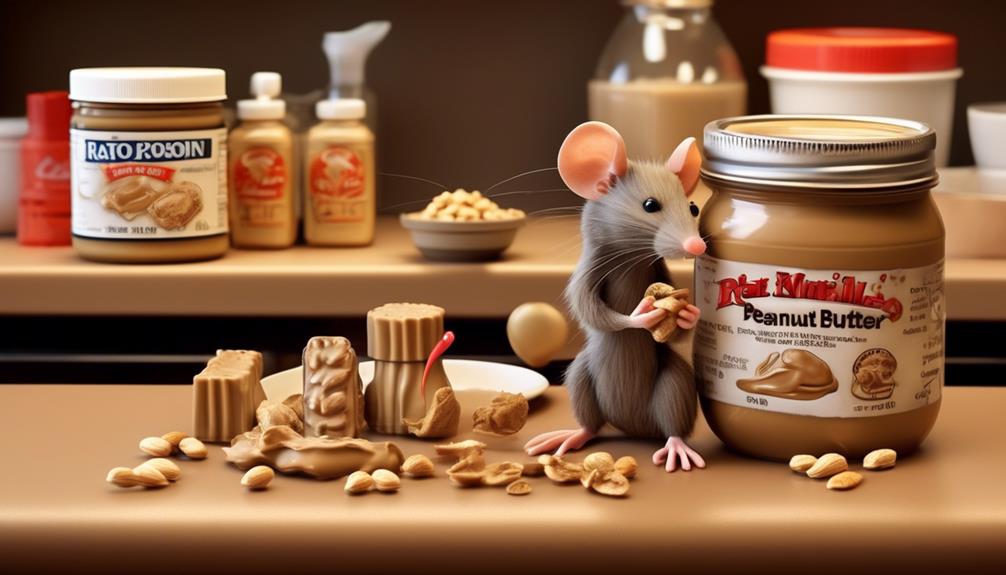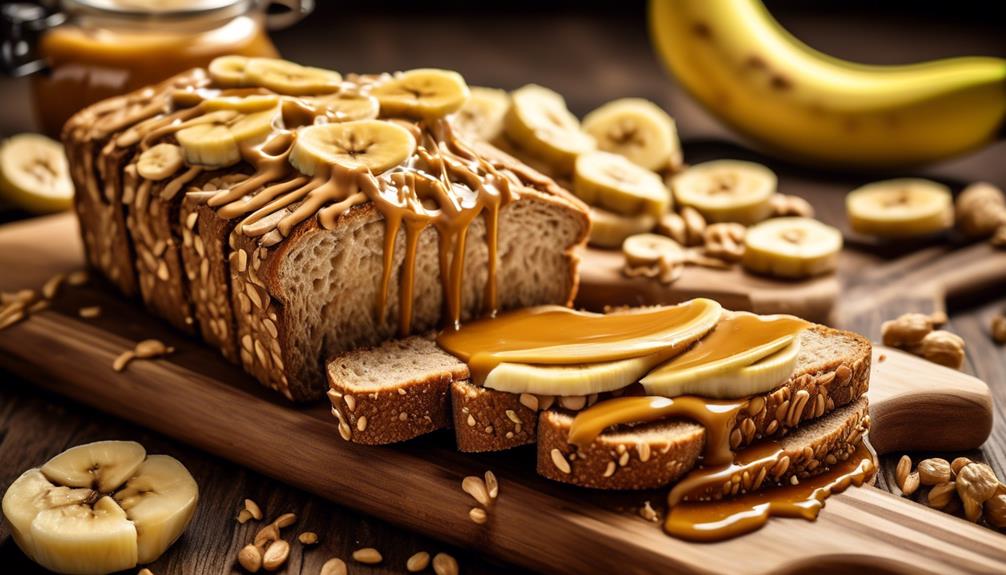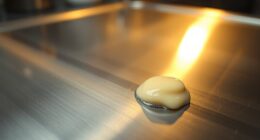Peanut butter can be compared to a thick forest, filled with secrets and enigmas that leave you questioning why it is so calorie-dense. Many of us have experienced this, analyzing the nutrition facts label, puzzled by the deceptively innocent condiment that carries a high calorie count.
But fear not, for we're about to uncover the secrets behind this enigma. So, let's unravel the science and explore the surprising reasons behind peanut butter's calorie density, shedding light on what makes it a nutritional powerhouse or a potential pitfall.
Key Takeaways
- Peanut butter's high caloric density is primarily due to its high fat content, with fats providing 9 calories per gram.
- The fats in peanut butter are predominantly heart-healthy monounsaturated fats, making it a valuable addition to a balanced diet.
- Protein also contributes to the caloric density of peanut butter, with each gram of protein providing 4 calories.
- Some commercial brands may increase the caloric density of peanut butter by adding extra sugar, so it's important to choose natural varieties without added sugars for a healthier option.
Peanut Butter's Caloric Density
Peanut butter's caloric density arises from its high fat and protein content, both of which contribute significantly to its energy value. With approximately 16 grams of fat in a 2-tablespoon serving, peanut butter is undeniably high in fats. These fats are predominantly monounsaturated, which are considered heart-healthy. However, they also play a pivotal role in elevating the caloric content of peanut butter. Moreover, the protein content in peanut butter, with each gram contributing 4 calories, further adds to its caloric density.
It's important to note that while the fats in peanut butter are healthy, they're dense in calories. Additionally, certain commercial brands may augment the caloric density by incorporating extra sugar. This combination of high-fat, protein-rich, and potentially sugary elements results in peanut butter being a weighty source of calories.
To navigate this, opting for natural peanut butter with minimal ingredients can help manage the caloric impact. Understanding the caloric density of peanut butter and making informed choices about portion sizes and product types is crucial for those seeking a healthy balance in their diet.
Nutrient Composition of Peanut Butter

When analyzing the nutrient composition of peanut butter, it becomes evident that its high-calorie and fat content necessitates mindful consumption, particularly for individuals focusing on weight management. Despite being high in calories, peanut butter offers a good amount of protein and healthy fats, but it's important to be aware of added sugars in some varieties. Here's a breakdown of the nutritional content in a typical two-tablespoon serving of peanut butter:
| Nutrient | Amount |
|---|---|
| Calories | 191 |
| Fat | 16g |
| Protein | 7g |
| Sugar | 3g |
Peanut butter's high fat content contributes to its caloric density, making portion control crucial for those watching their calorie intake. However, the protein content and healthy fats make it a valuable addition to a balanced diet. Opting for natural peanut butter without added sugars can further enhance its nutrient profile. When incorporating peanut butter into your diet, it's essential to consider your overall calorie intake and nutritional goals. Selecting high-quality, nutrient-dense options and being mindful of portion sizes can help maximize the benefits of this popular spread while managing calorie consumption.
Metabolic Impact of Peanut Butter

The metabolic impact of consuming peanut butter is influenced by its high calorie and fat content, which may have implications for overall health and weight management. When considering the metabolic impact of peanut butter, it's important to recognize that its high protein and fat content can play a significant role.
Here are some key points to consider:
- Peanut butter contains 190 calories per 2 tablespoon serving, primarily due to its high fat content.
- The monounsaturated fats in peanut butter can potentially reduce your risk of heart disease and aid in weight management.
- Including protein-rich foods like peanut butter in your diet can help with fat loss, as protein assists in preserving muscle mass during weight loss efforts.
Understanding the metabolic impact of peanut butter is crucial for individuals aiming to manage their weight effectively. Despite its calorie density, when consumed as part of a balanced diet, peanut butter may not necessarily lead to long-term weight gain. Moreover, its protein and calorie content make it a suitable choice for those looking to build muscle.
It's essential to consider these metabolic effects when incorporating peanut butter into your diet for overall health and weight management.
Factors Contributing to Caloric Density

High fat content, essential nutrients, and protein contribute to the caloric density of peanut butter, making it a source of energy with nutritional benefits. The high-fat content, particularly monounsaturated fats, plays a significant role in its caloric density.
Additionally, peanut butter is packed with essential vitamins, minerals, and protein, further contributing to its caloric density while offering numerous health benefits. The protein content not only adds to its caloric density but also makes it a valuable source of energy, promoting a sense of fullness.
The caloric density of peanut butter can also be influenced by portion size. While the recommended serving size is relatively small, it's easy to exceed, leading to a higher caloric intake.
Furthermore, the processing of peanut butter can impact its caloric density. Some varieties may contain added sugars, oils, and trans fats, further increasing their caloric density.
Processing Effects on Caloric Content

During the processing of peanut butter, the roasting of peanuts can significantly impact its caloric content.
Additionally, the addition of oils or emulsifiers during processing can contribute to the high calorie density of certain peanut butter varieties.
It's important to consider the processing methods used, as they can influence the overall caloric content and consistency of peanut butter.
Impact of Roasting
How does the roasting process affect the caloric content of peanuts used in making peanut butter?
Roasting peanuts for peanut butter can significantly impact their caloric content. The process reduces the water content, making the peanuts denser and more calorie-dense. Additionally, roasting leads to Maillard reactions, creating complex, calorically dense compounds and enhancing flavor and aroma. This, in turn, contributes to the overall increase in energy density. Moreover, roasting can cause a notable increase in the fat content of peanuts, further elevating the calorie content of peanut butter.
In summary, the impact of roasting on the caloric content of peanuts used in making peanut butter is multifaceted, involving the loss of moisture, the development of calorically dense compounds, and the increase in fat content.
- Loss of moisture concentrates energy in the form of fat and protein.
- Maillard reactions enhance flavor and aroma, leading to the development of calorically dense compounds.
- Roasting increases the fat content of peanuts, contributing to the overall higher calorie content of peanut butter.
Oil Content Influence
The impact of roasting on the caloric content of peanuts used in making peanut butter is multifaceted, involving the loss of moisture, the development of calorically dense compounds, and the increase in fat content, which directly influences the oil content and, consequently, the caloric density of the final product. When processing peanuts into butter, the method can lead to an increase in oil content, contributing to its high calorie count. Commercial peanut butter brands may incorporate added oils and fats during processing, elevating the overall fat and calorie content. Some processing methods result in higher oil extraction from peanuts, yielding a more calorically dense product. This increase in oil content impacts the monounsaturated fats and polyunsaturated fatty acids present in the peanut butter, affecting its nutritional profile and caloric density.
| Processing Effects | Oil Content Influence | Caloric Density |
|---|---|---|
| Roasting | Increase | Higher |
Peanut Butter's Energy-Dense Nature

Peanut butter's energy-dense nature stems from its nutrient-rich ingredients and high fat content, which provides a substantial amount of calories in just a small serving.
The healthy monounsaturated fat in peanut butter contributes to its energy density, making it a valuable source of sustained energy for physical activities and endurance exercises.
It's important to be mindful of portion sizes to effectively manage calorie intake, especially considering peanut butter's high energy density.
Nutrient-Rich Ingredients
Rich in essential nutrients, peanut butter's energy-dense nature stems from its high content of fats and proteins. While its high calorie count may raise concerns, the nutrient-rich profile of peanut butter offers several health benefits. Here are a few key points to consider:
- Protein-Rich Foods: Peanut butter is an excellent source of plant-based protein, which is essential for muscle repair and growth.
- Healthy Diet: Despite its calorie density, peanut butter contains heart-healthy monounsaturated fats and important vitamins and minerals, making it a valuable addition to a balanced diet.
- Weight Loss: When consumed in moderation, the protein and fiber in peanut butter can promote satiety, potentially aiding in weight management.
High Fat Content
Transitioning from the discussion of nutrient-rich ingredients, we now examine the high fat content of peanut butter, which contributes significantly to its energy-dense nature. Peanut butter contains 16 grams of fat per 2-tablespoon serving, making it high in calories. The fat content in peanut butter primarily consists of heart-healthy monounsaturated fats, contributing to its caloric density. This high fat content is a major factor in making peanut butter an energy-dense food. However, it's important to consume it in moderation, especially for individuals watching their calorie intake or trying to lose weight. Understanding the high fat content in peanut butter can help make informed decisions about its consumption. Below is a table summarizing the nutritional content of peanut butter per serving:
| Nutrient | Amount per Serving |
|---|---|
| Calories | High |
| Fat | 16g |
| Monounsaturated | Heart-healthy |
| Shelf Life | Long |
Caloric Value of Peanut Butter

How does the high fat content of peanut butter contribute to its substantial caloric value? Peanut butter's caloric value is primarily due to its fat content, which provides energy. The high-fat content of peanut butter plays a significant role in its caloric density. Here's how it works:
- Energy-Dense Food: The fat content in peanut butter makes it an energy-dense food, meaning it provides a high number of calories relative to its weight.
- Calorie Source: The fat in peanut butter serves as a concentrated source of calories, contributing to its high caloric value.
- Nutrient-Rich: Alongside being high in calories, peanut butter is also a good source of essential nutrients, such as protein, fiber, and healthy fats, making it a valuable addition to a balanced diet.
Peanut butter's high caloric value shouldn't discourage its consumption, as it offers a range of beneficial nutrients. Understanding the factors contributing to its caloric density allows for mindful inclusion of peanut butter in a well-rounded diet.
Role of Fats in Peanut Butter

The fats in peanut butter, particularly the monounsaturated fats, contribute significantly to its calorie density and are beneficial for heart health when consumed in moderation. These healthy fats have been associated with a reduced risk of heart disease, as they can help lower LDL (bad) cholesterol levels and maintain or improve HDL (good) cholesterol levels. Additionally, the presence of polyunsaturated fats in peanut butter provides essential omega-6 and omega-3 fatty acids, which play a critical role in various physiological functions.
Research suggests that the fats in peanut butter may also support muscle mass and strength. The monounsaturated fats, in particular, have been linked to improved muscle function and reduced muscle wasting in older adults. Furthermore, the fat content in peanut butter aids in the absorption of fat-soluble vitamins, such as vitamin E, which contributes to its nutritional value.
While the fats in peanut butter contribute to its high calorie content, they also offer important health benefits. When consumed as part of a balanced diet, the fats in peanut butter can contribute to overall well-being and heart health.
Protein Content in Peanut Butter

The pivotal role of nutrients in peanut butter extends beyond its fats, with the protein content playing a significant part in its nutritional value and potential health benefits.
Peanut butter is a good source of protein, with two tablespoons providing around 7-8 grams of protein.
The protein in peanut butter can help build and maintain muscle, making it a valuable addition to a balanced diet.
Including protein-rich foods like peanut butter can increase feelings of fullness and support weight loss efforts.
Adding peanut butter to meals or snacks can help curb appetite and reduce the desire to eat more, promoting weight loss.
Incorporating peanut butter into a diet can support weight maintenance and provide essential nutrients alongside its protein content.
Peanut butter's protein content is a key factor in its nutritional value.
- Two tablespoons of peanut butter provide around 7-8 grams of protein.
- The protein in peanut butter can help build and maintain muscle.
- Including protein-rich foods like peanut butter can increase feelings of fullness and support weight loss efforts.
Sugar and Caloric Content

Peanut butter's sugar and caloric content significantly contribute to its nutritional profile, impacting its suitability for various dietary needs and goals. When comparing different types of peanut butter, it's crucial to consider the added sugar and caloric differences. For instance, traditional peanut butter contains added sugars and higher calories than powdered peanut butter, affecting its overall healthiness and impact on daily caloric intake.
| Peanut Butter Type | Added Sugars | Calories | Impact on Daily Caloric Intake |
|---|---|---|---|
| Traditional | Yes | High | Significant |
| Powdered | No | Lower | Reduced |
| Natural | Minimal | Moderate | Balanced |
The added sugars in traditional peanut butter can lead to extra calories, potentially exceeding the recommended daily value. On the other hand, powdered peanut butter offers a lower-calorie alternative with no added sugars, making it an attractive option for individuals looking to manage their calorie intake. When selecting peanut butter, understanding its sugar and caloric content is essential for making informed choices aligning with dietary preferences and health objectives.
Nutritional Density of Peanut Butter

Comparing different types of peanut butter, it's essential to consider the nutritional density as it directly impacts its suitability for various dietary needs and goals. When evaluating the nutritional density of peanut butter, we find that it's a powerhouse of essential nutrients, making it a valuable addition to a balanced diet. Here are a few important points to consider:
- Essential Nutrients: Peanut butter isn't just high in calories; it also provides essential nutrients like vitamin E, magnesium, and potassium, making it a good source of protein, fiber, and healthy fats.
- Weight Management: The protein and healthy fats in peanut butter can promote fullness, aid in weight loss, and help preserve muscle mass during weight loss efforts.
- Healthful Consumption: When consuming peanut butter, it's important to be mindful of portion sizes and overall calorie intake, as excessive consumption can lead to weight gain over time. Choosing natural varieties without additives, measuring portion sizes, and using it as a dip or spread on healthy snacks are crucial for healthful consumption.
Understanding the nutritional density of peanut butter allows individuals to make informed choices about its inclusion in their diet, supporting overall health and well-being.
Impact on Daily Caloric Intake

Consuming peanut butter can lead to a significant increase in daily calorie intake due to its high caloric content, with just 2 tablespoons providing around 191 calories. This impact on daily caloric intake is crucial for individuals aiming to manage their weight or adhere to specific calorie targets. Including peanut butter in the diet without adjusting portion sizes can result in a substantial increase in daily caloric intake, potentially hindering weight management goals.
However, being mindful of portion sizes and incorporating peanut butter into a balanced diet can help manage its impact on daily caloric intake. It's essential to consider the calorie content of peanut butter when planning meals and snacks to ensure it aligns with overall daily calorie goals.
Furthermore, opting for natural peanut butter without added sugars or oils can help mitigate the impact on daily caloric intake while still enjoying its nutritional benefits. Thus, maintaining awareness of the caloric implications of consuming peanut butter is essential for effectively managing daily calorie intake when integrating this high-calorie food into the diet.
Frequently Asked Questions
Is Peanut Butter Too High in Calories?
Peanut butter's calorie content is high due to its fat content, which provides essential nutrients like protein and healthy fats. While it can contribute to weight gain if overconsumed, it can still be part of a balanced diet when enjoyed in moderation.
Considering portion sizes and choosing natural varieties without added sugars and oils is crucial. Its protein and healthy fats can promote fullness, aiding in weight loss and reduction of appetite.
Why Does Peanut Butter Make Me Gain so Much Weight?
Peanut butter may cause weight gain when consumed in excess due to its high calorie and fat content. However, it's not just peanut butter alone that leads to weight gain. Our overall diet and lifestyle play significant roles.
Moderation is key, as the protein and healthy fats in peanut butter can also promote feelings of fullness and aid in weight management. Being mindful of portion sizes and choosing natural peanut butter can minimize its calorie impact.
Where Do the Calories in Peanut Butter Come From?
Where do the calories in peanut butter come from?
The calories in peanut butter primarily come from its high fat and protein content. With 16 grams of fat and 7 grams of protein per 2-tablespoon serving, peanut butter is calorie-dense.
The type of fat, mainly monounsaturated fat, contributes to its caloric content and provides health benefits.
Additionally, the 7 grams of carbs per serving also contribute to its calorie count, making it an energy-rich food.
Is 2 Tablespoons of Peanut Butter a Day Too Much?
We've found that consuming 2 tablespoons of peanut butter daily can be a healthy addition to a balanced diet.
It provides essential nutrients such as protein, healthy fats, and fiber, which can promote a feeling of fullness and aid in weight management.
However, it's important to consider the overall calorie intake and ensure that peanut butter is consumed in moderation as part of a well-rounded diet.
Conclusion
In conclusion, while peanut butter is high in calories, it can still be a part of a balanced diet when consumed in moderation.
It's important to note that 2 tablespoons of peanut butter provide about 8 grams of protein, which can contribute to satiety and muscle repair.
Incorporating peanut butter into a diet rich in fruits, vegetables, and whole grains can help balance out its caloric density with important nutrients.
